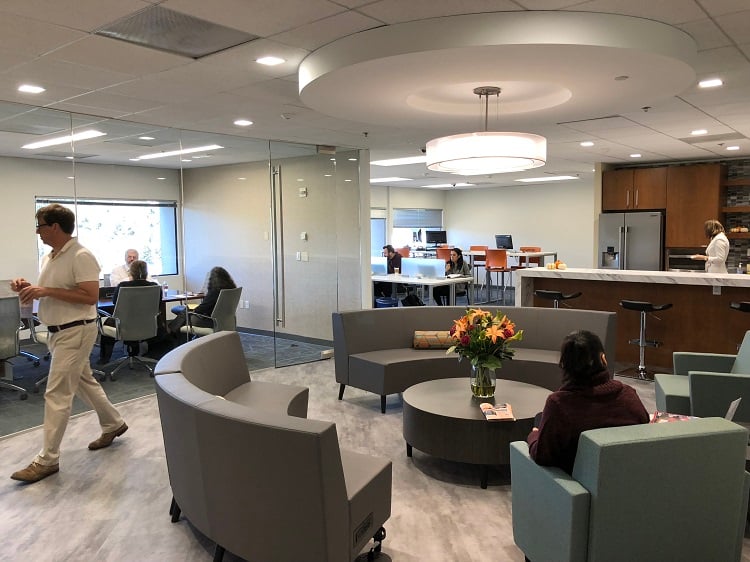I am tempted to say: Yes, be careful!
This answer may surprise many of you. I have been an enthusiastic observer of coworking ever since ‘The Work Club’ started in Emeryville, CA, in 2003. I believe that all players in the Workspace-as-a-Service arena will eventually converge to offer a menu of choices ranging from private offices and professional meeting rooms to coworking options, all under the same roof. Walking the talk, as CEO of Pacific Workplaces, I drove our own experimentation with coworking 3 years ago.
So am I disavowing my own coworking strategy while at the helm of Pacific?
My good friend Robert Cher reminded me of the merits of staying centered on one’s core competency. He recently wrote this brilliant Harvard Business Review post “Tinkering with Strategy can Derail Midsize Companies”. The essence of the article is that a common mistake by many midsize firms CEOs is to jump too quickly to the next idea, when they would often be better off sticking to what they know best.
That principle applies to Workspace-as-a-Service providers, including small operators. For a business center to reinvent itself in the coworking space requires a significant cultural shift. The success of coworking relies on the capacity the operator has to foster a vibrant community. Not just one that finds itself out over time, like with business center customers discovering each other by the water cooler and through a series of networking events hosted by the operator, but one that is actively lead, often selective, and with a strong and deliberate orientation.
For example Enerspace Coworking has a strong emphasis on “wellness”, which also means that if you are an avid donuts eater who likes to smoke cuban cigars, you’ll probably select yourself out of consideration. But conversely, wellness related events hosted at the site can be extremely well attended, creating quicker and stronger bonds between the members.
Providing exceptional customer service in highly professional places (like many business centers do) does not create a selective culture of folks who share common values. It may bring under the same roof the highly professional attorney, who likes donuts and Cuban cigars after a good round of golf at the Olympic club, and the bootstrap entrepreneur who runs 2 miles every morning and volunteers at the homeless shelter at night. What drove them to the business center is the quality of the workspace and the services around it, not each other. They may eventually discover that they have more in common than meet the eye, but that will be a longer, serendipitous, process. Meanwhile, they may be perfectly satisfied with the quality of their private office, the professional meeting rooms, and they may equally love the ever-so-helpful person at the front desk who meets them with that engaging smile.
Now add a coworking offering to that business center mix and what do you get? What sense to give to that new coworking community? What bond?
If the community is selective, which one between the Cuban cigar lover or the homeless shelter volunteer will feel out of place? And if the coworking place is open and inclusive, then is it really coworking or simply hotdesking, with an accent on convenience and inexpensive access to open desks?
How much disruption will that new ‘coworking’ initiative create on the business center strategy? Would the management efforts be better invested in growing the virtual office business? Will the opportunity cost of converting a portion of the space into a coworking place be worth the return? In the end, will the operator tinker too much with its strategy and core competency to the point of derailment?
Back to my experience at Pacific Workplaces. The coworking corners we deployed in several centers did not generate the immediate enthusiasm and displacement of coworking communities to our centers we had hoped for. They turned out to be good ideas, but as “touchdown space” with meaningful marketing and service quality benefits, but without tremendous ROI.
Last year, as par of our continual experimentations with coworking, we decided to partner with Jamie Russo, an experienced coworking operator, and jointly opened Enerspace Palo Alto, collocated in the same building as our Palo Alto Pacific Workplaces, but with a separate entrance, distinct brand, and separate management.
This was based on the realization that our Pacific Workplaces managers could not overnight re-invent themselves as coworking community leaders, and that it could perhaps even be counter-productive.
That seems to be the winning recipe so far. Pacific Workplaces can continue their progressive journey towards offering “Proworking” options within their walls, but without disrupting their current strength, while keeping the main focus on being the provider of choice for on-demand workplaces in their areas. At the same time, we collectively benefit from the experience of being a true coworking operator through our partnership with Enerspace, with a good ROI and the learning benefits associated with it, without having to tinker with our core competency.
In the process, we showed that we are good disciples of his Eminence Robert Sher. Maybe he’ll even use us as a case study in his next bestseller?
Laurent Dhollande
CEO, Pacific Business Centers (rebranded as Pacific Workplaces)

